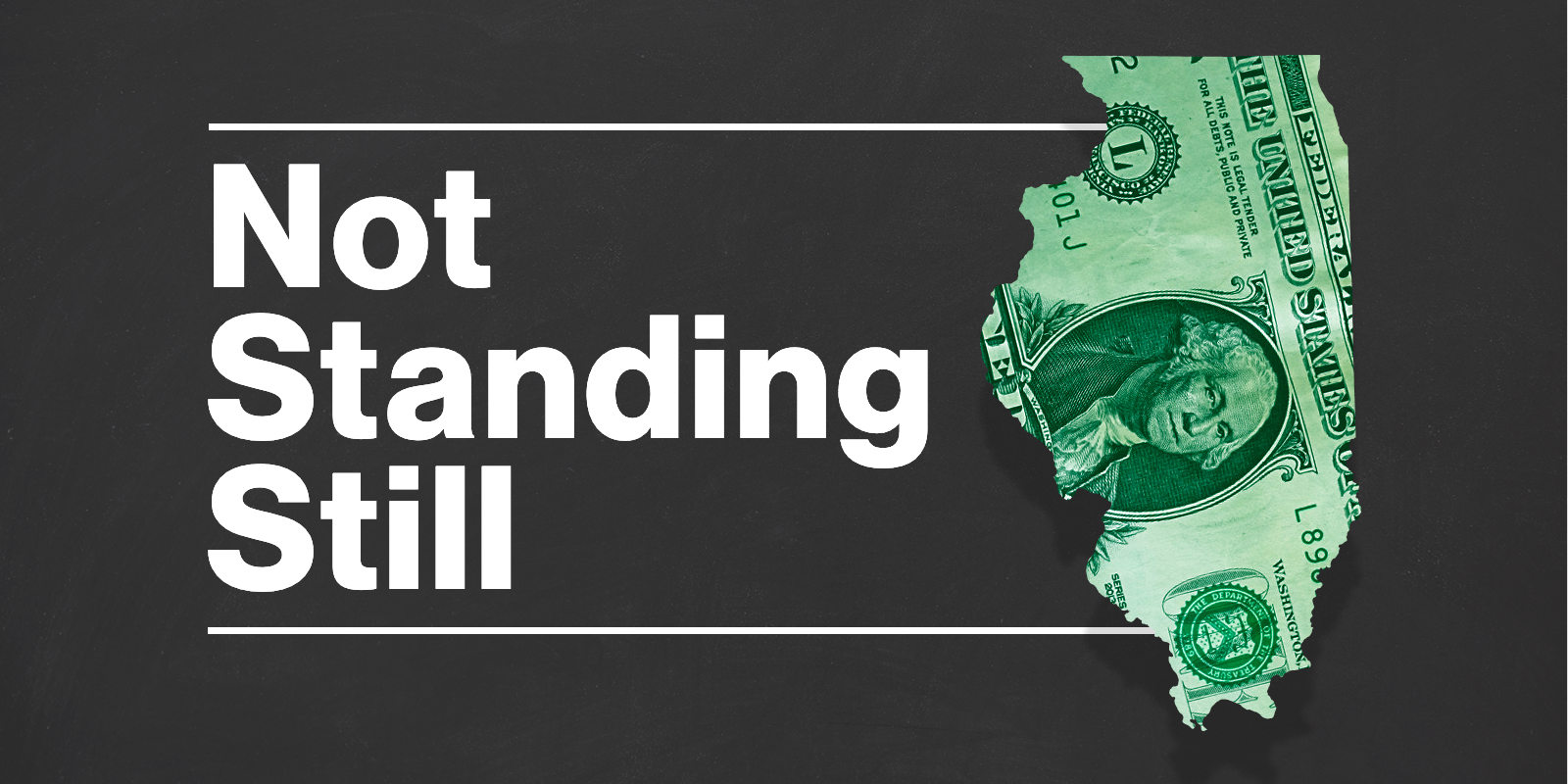Dr. Todd Dugan: Not Standing Still
How political, educational, and community leaders made school funding in Illinois more equitable

Guest Writer: Dr. Todd Dugan, Superintendent of Bunker Hill CUSD #8

Is change possible in public education? Critics of the system, jaded by years of bureaucracy, inefficiency, and inequity, might say no. But over the last decade, I’ve watched as my home state of Illinois made a landmark change, one that made education more adequate and equitable for hundreds of districts and millions of kids. I know, firsthand, that change for the better can happen.
That’s not to say that it comes easily. In Illinois, change took decades of pent-up frustration brought on by inequitable funding. It took dozens of shot-down solutions and long stretches of political infighting in the Illinois General Assembly. It took the dedication of a leader and the strength of a grassroots movement. It took time—but it happened.
The Problem
Picture this: a place where two million public school students rely on funding from a system ranked dead-last in the nation for equity. Where for every dollar spent on their peers, only $0.81 is spent on students from low income households. Where some districts are forced to slash transportation routes, doubling travel time for kids, while others add orchestra classes and build STEM labs. Where savage inequalities are exacerbated by a decades-old, broken funding system.
That was Illinois, the fifth-largest economy in the country, in the years leading up to its landmark funding reform.
Two million Illinois public school students relied on an inequitable funding formula.
For every $1 spent on their peers, only $0.81 was spent on students in low-income households.
Illinois ranked dead-last in the nation for equity.
How did we find ourselves in such a state of inequity? The truth is that we’d been there a long time. Years of chronic disinvestment in public education had resulted in years of prorated funding. Until 2017, Illinois’ foundation formula distributed a set amount of funding per pupil to each district, but over time, fiscal issues in Springfield resulted in less and less funding toward this foundation amount. As a result, districts were increasingly forced to rely on local funding to make up the difference.
For districts in affluent areas, this was fine; they could raise the money they needed via property taxes. For others, however, it wasn’t so easy. The result was a very unequal distribution of school funding across the state.
For many districts, these inequities led to devastating day-to-day consequences. Thousands of teachers and teacher aides across the state lost their jobs, schools in the poorest communities shut their doors, and the achievement gap grew ever wider. In my own district, we felt the effects of the outdated formula, cutting our transportation by 60% and completely eliminating bussing for extracurriculars.
It was clear that the Land of Lincoln needed to secure a path forward to a more progressive funding formula. But at a time when the state of Illinois had been operating without a budget for two consecutive fiscal years, accomplishing such a daunting and controversial task would be no small feat. It wasn’t the need to address education funding that was in dispute, but the details. In the beginning, there was no shortage of proposals aimed at addressing the school funding crisis. Most never made it to bill status due to opposition from, of all people, educators.
Ideas for reform varied from lowering funding for all districts to ceasing funding for districts with plentiful reserves. But across the board, they only achieved division among the 800+ independent school districts which stood either to gain or lose under the various proposed models.
I witnessed this division myself at a leadership summit at the State Capitol in the spring of 2013. A board member from an affluent suburban district said his community expected orchestra and early bird foreign language classes and could not fathom any more cuts. A visible ripple coursed through the room; many downstate rural school leaders had long ago slashed art, music, and even some athletics simply to keep their doors open.
The Solution
Enter the Evidence-Based Funding for Student Success Act, the solution Illinois education needed. The Evidence-Based Funding (EBF) model establishes “adequacy targets” for each district by calculating the cost of educating the students in that district, taking into account 27 elements proven to significantly affect achievement. These factors range from staffing needs to subsets of students that cost more to educate, such as English learners and students from low-income households. After accounting for a district’s ability to meet this cost with local funding, the state fills in the rest.
Under this plan, no district loses funding; instead, there are provisions in place to ensure that future budget issues won’t disrupt education funding. There are no “winners and losers”—only “winners and greater winners.”
The Team
Even at the outset, the EBF model looked promising. But if it was going to have a chance at becoming law, the idea needed both a leader and a strong support base. The cause found its champion in State Senator Andy Manar, a Democrat from the small, working-class town of Bunker Hill in downstate Illinois.
For years, Manar went to the mat for evidence-based funding. He traveled the state rallying support at town hall meetings, chaired a bipartisan Education Funding Advisory Committee, and saw the EBF bill through its many iterations. Leading the way for reform in Illinois’ political climate demanded will, determination, and courage. Despite the five-year, uphill battle he faced, Manar pressed on.
But leadership alone would not be enough to solve the problems facing public education in arguably the most turbulent financial times in Illinois history. The crisis of inequity and inadequacy facing the Prairie State was not created, nor could it be solved, by one person alone. Rather, it would take a collective effort, a grassroots public campaign with a single objective: ensuring adequate funding to effectively educate every child in the state, regardless of ZIP code.
Many Illinois education proponents—the Illinois Association of School Administrators, the Illinois Principals Association, the Illinois Association of School Boards, just to name a few—publicly backed the bill. And across the state, communities followed suit, from organizations like Advance Illinois to Citizens for Education to the League of Women Voters to churches and chambers of commerce.
The Struggle
Even with Senator Manar at the helm and the growing rallying cry from the community, the journey leading up to Governor Bruce Rauner signing the EBF model into law was long and winding. Initially, there was great disagreement over the details of the plan as laid out in the first proposed EBF bill, Senate Bill 1. Early concerns centered around some districts losing out while others saw increased funding. Over time, tempers flared over the long-running Illinois political tension between Chicago and “downstate.”
At issue was a shift in state money toward Chicago Public Schools’ pension system, as this was the only district in the state up to that point not to have its pension obligations managed by the state. Critics saw this as a “bailout” and opposed other measures as disproportionately benefiting the state’s largest school district. This tension resulted in Governor Rauner vetoing Senate Bill 1.
It took a lot for lawmakers to eventually agree with both the governor and with one another. Senator Manar came back to the table with a revised version of the same idea: Senate Bill 1947. Democratic lawmakers had to make concessions to Republicans, primarily by agreeing to a pilot program for a new voucher system, increased charter school funding, and provisions allowing school districts to pursue property tax relief. Even so, the measure was hard to pass.
It took two attempts for the House to pass an amended form of Senate Bill 1947, but they finally reached a consensus that both parties and Governor Rauner were able to accept. The drama wasn’t over, however, as a subsequent bill to actually fund the new system was vetoed by the governor over technicalities. Both chambers instead overrode his veto and finally made evidence-based district funding a reality in Illinois. The bill was signed into law on August 31, 2017, taking a huge step toward the end of state-perpetuated inequity.
The Results
Since it was passed, the EBF model has funneled an additional $650 million into Illinois’ public schools. Across the state, that extra funding is making real change. Districts that once struggled are now reinstating their shuttered arts programs, investing in innovative early childhood education techniques, and instating brand new after-school STEM programs. My own district, Bunker Hill CUSD #8—Senator Manar’s alma mater, in fact—is feeling the love, too. We’ve reduced our class sizes and increased the rollout of technology in our classrooms, and we’re planning on hiring a new special education teacher for the coming school year.
Of course, there’s still a long way to go. But under the new formula, no school is operating at less than 45% of its adequacy target—a substantial step up from the days before the change. It’s our hope that by 2027, pending continued investments from the state, all our districts will have met their targets. We may be on a slow road to our goal, but we’re not standing still anymore. We’re moving forward.
Change isn’t easy. It takes grit, commitment, and leadership. It takes strong community buy-in. It takes political courage and compromise. It takes patience. But when people tell me public schools are too caught up in red tape, that they’re too set in their ways, that nothing will ever change, I know that they’re wrong. In Illinois, change is coming. It’s already here. And two million kids are reaping the benefits.
Be a Guest Writer
Want to share your story, idea, or breakthrough in SchoolCEO?
Email: editor@schoolceo.com

SchoolCEO is free for K-12 school leaders. Subscribe below to stay connected with us!

